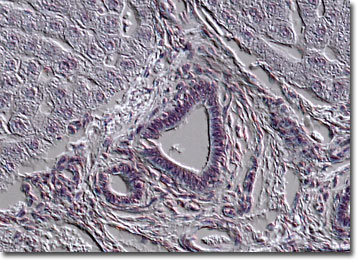Differential Interference Contrast Image Gallery
Mammalian Liver Thin Section
The liver is the largest and most complex gland in the vertebrate body. Though the size and shape of the crucial organ may vary from species to species, all livers perform similar functions.

In humans, approximately one and a half liters of blood pass through the liver each minute. As this occurs, the liver removes waste and toxic matter from the blood, obliterates old red blood cells, and regulates blood volume. The liver is also responsible for producing the digestive enzyme bile and metabolizing fat, protein, and carbohydrates, as well as storing glycogen and synthesizing blood-clotting factors. Yet, the liver does not carry out its many functions independently. The gland works in very close conjunction with the gall bladder and the intestines.
Essential to life, the liver, which is susceptible to many diseases and infections, can lead to serious medical problems if it is damaged. One of the most obvious signs of liver impairment is the yellowing of the skin and eyes known as jaundice. Jaundice may occur from a variety of liver malfunctions and, therefore, tests must be carried out to make an accurate diagnosis. In many instances of liver damage, as in cases of cirrhosis or hepatitis, bed rest and complete avoidance of alcoholic beverages may result in a remarkable improvement of health.
